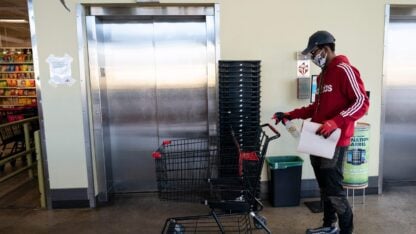Next week, bars and nightclubs in Georgia will be allowed to reopen if they can meet a set of guidelines. Gov. Brian Kemp announced the decision Thursday, while also extending the state’s public health emergency declaration.
Meanwhile earlier this week, Atlanta Mayor Keisha Lance Bottoms updated a different set of guidelines, suggesting that everyone should still be sheltering in place.
Here’s a breakdown of how their guidance differs, and who public health experts recommend people listen to (spoiler alert: the answer is, it depends).
A Quick Version Of Where They Diverge
The biggest difference is probably the mayor’s recommendation to stay home, which goes for everyone.
The governor allowed the statewide order to shelter in place to expire, though he is still ordering people who are at risk — either people who are 65 or older or people with underlying medical conditions — to continue sheltering in place until mid-June, except for getting out for essential needs.
Another big difference is in retail and restaurant operations. The mayor recommends to-go and curbside pickup only, no dining in. That’s something the governor is allowing.
For more detail, the city of Atlanta’s five reopening phases – as of Wednesday, the city is in Phase 2 – are described in this PDF.
The governor’s executive order updating his guidance as of Thursday is in this PDF.
What’s Legally Enforceable?
Kemp has explicitly said local governments can’t make their own rules on this, so Bottoms can only make recommendations.
The governor’s rules are enforceable. A violation is a misdemeanor.
So Whose Guidance Should People Listen To?
Here’s why the answer is complicated, according to Colin Smith, who teaches at the Georgia State School of Public Health, and whose expertise is in using epidemiology to guide policy: public health is local.
Smith recommends that people look for guidance on as local a level as they can find, since conditions are different in different places.
“Pay most attention to what your local public health officials say, and the various political leaders that they work most closely with,” he says. “Because public health interactions and interventions obviously don’t happen at the state or national level, they happen at the local level.”
He suggests looking to a county health department or a state health district. He says he does look to the White House, the Centers for Disease Control and Prevention and to the state of Georgia for guidance, but he starts as local as he can and then works his way up.
Basically, the more local the guidance is, the more it’s going to reflect what’s going on around you.
Why Do The Mayor’s And The Governor’s Recommendations Differ?
From a public health standpoint, it makes sense that Bottoms has different guidance from Kemp, because she is thinking about a different population, according to Stephanie Miles-Richardson, director of the public health program at Morehouse School of Medicine.
Atlanta’s population has a greater percentage of black residents than Georgia in general, and the coronavirus is disproportionately affecting people of color. Atlanta is also denser than anywhere else in Georgia.
“I think that what we’re seeing is guidance that reflects those population differences,” she says.
On Friday, Bottoms explained it in similar terms to a Congressional subcommittee, saying that the city is especially vulnerable to COVID-19.
“We’re home to many residents with underlying conditions such as diabetes, heart disease and cancer,” she said. “In fact, all four of my children suffer from asthma.”
Does Anyone Agree On Anything?
“I look at data to inform myself,” Dr. Carlos del Rio, a professor of medicine and epidemiology at Emory, told reporters earlier this week. “The data tells me I should continue sheltering in place. I’m not ready to go to a restaurant yet. I’m still ordering out; I’m still eating at home.”
Miles-Richardson and Smith also both said they aren’t eating in restaurants yet, either.
There are things Kemp and Bottoms agree on, too.
They’re both encouraging people to wear masks in public, especially in places like grocery stores where it could be tough to maintain distance from other people.
“If you’re wearing a mask, you’re protecting other people. Not everybody’s doing that. We’re asking them to do that,” Kemp said at a press conference Thursday.
They are both strongly encouraging social distancing. And both say if you’re 65 or older, or have health conditions making you more at risk, stay home unless it’s for something essential.








